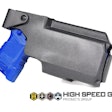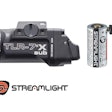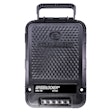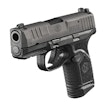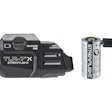If you believe the media, it would seem as if negligent shootings of law enforcement officers during training are almost a daily event. In actuality, such incidents are quite rare, but that doesn’t mean we shouldn’t take every necessary step to prevent these tragedies.
Law enforcement is a dangerous occupation and we all accept a certain amount of risk when we hit the street. We all rely on our training to minimize this risk, and we expect that this training will be as risk-free as possible.
Yes, and we even accept some level of risk during combative training. Body contact in police training can result in personal injury, the same as it can in an organized sport. However, while we may expect bumps and bruises from our training, what we do not expect is gunshot wounds.
A hot weapon, except on the range pointed at a backstop we know will absorb live rounds, is unacceptable. Unfortunately, as noted above, firearms with live ammo do make their way into the training arena…oftentimes with tragic results.
The Brain Safety
All law enforcement officers must understand one simple, but undeniable fact; firearms safety is a function of the brain, period. While it is nice to have products that are manufactured to be “safe,” there is no such thing as a safe firearm.
Remember rule one of firearms safety: All guns are always loaded. If guns were totally safe, they would be of no use to us as defensive tools. Take some time and go review a wide array of involuntary or negligent discharges and you’ll see that the vast majority occur when a firearm is being handled for reasons other than actually shooting. In the training arena, negligent discharges are usually due to the gun being needed as a training prop or aid and a real gun is used for this purpose. Then somehow the empty gun becomes loaded and an unsuspecting officer is shot.
Distraction and Disaster
How do these guns “become loaded?” The majority of the time it is due to someone not paying attention…they are loaded because somebody had what we officers like to call a “brain fart.” For a split second, the instructor or student was not staying switched on to what they were doing and the gun was loaded.
The problem is, people tend to do other things while they are working with firearms. They carry on conversations, they drink coffee, or become distracted in some fashion. This is absolutely unacceptable.
Whenever firearms are being used or handled, total concentration must be paid to the gun and nothing else. Ask yourself if you really remember loading your gun before you went on duty. Some of you will no doubt say, “Yes,” and you will mean it. But some of you, if you are being honest, will not. You were talking to your wife at home or your buddies in the locker room while you went through the motions of loading up. The gun can easily become just another tool on the belt, being handled without due thought. And that’s not good.
Numerous training shootings occur when an instructor or student has thoughtlessly loaded his or her gun and then decided to do one more repetition or one more take-away. If the cops in question had really been paying attention to what they were doing when they loaded their guns, that last rep would have been out of the question. This does not happen to stupid people…it happens to distracted people. I’ll say it again; firearms safety is a function of the brain.
Fake Firearms
And there’s really no reason to have real firearms in the training environment, unless, of course, you are on a range. Training models are now available that can replace firearms in every way.
For force-on-force training scenarios, marking rounds and other products from companies like Simunition allow you to safely but realistically execute force-on-force training. Just be sure to follow the guidelines for protective gear and make sure that no weapons that haven’t been modified to only fire marking rounds are introduced into the training area.
If sims and marking rounds are too expensive for your agency or program, then Airsoft technology may be your answer. These gas-powered model guns shoot plastic pellets at about 350 feet per second, and they have developed a strong following at some police agencies. The models are very detailed, including safeties, mag releases, working slides, and some even weigh as much as a real weapon. Newer models even work the slide with each shot for a somewhat realistic recoil effect.
Using Airsoft guns, you can conduct very realistic force-on-force training involving multiple officers for as little initial outlay of funds as $1,000. Better yet, the cost of consumables is minimal. You can buy thousands of pellets for $10 and enough gas for 3,500 shots for about $12.[PAGEBREAK]
Airsoft guns and consumables can be found on the Web by merely searching “Airsoft.” They are manufactured by a number of different companies and are available in authorized models of popular police pistols and even long guns. For SWAT training, Armalite markets a series of all-metal battery-operated Airsoft long guns that includes MP5s and M4s complete with accessory rails. The Armalite models sell for about $250 and achieve muzzle velocities of up to 400 fps. Note: Always wear eye protection when training with Airsoft.
Blue Guns
For other instructional purposes the use of “non-guns” is the way to go. For many years, Ring’s Manufacturing made plastic firearms for the motion picture industry. The next time that you see your favorite action hero using a firearm, take a close look and see if there is a hole in the end of the barrel. While special effects people try to make sure this does not happen, every once in awhile you can see a gun that has a plugged barrel. If so, you can bet it’s a Ring’s gun.
The reason that Hollywood uses Ring’s products is because they are incredibly accurate representations of the real gun in both empty weight and feel. The guns will even exactly fit holsters for which the real gun is made, and they are so accurate that a number of the smaller holster manufacturers use Ring’s guns to manufacture holsters, as the cost of these simulated guns is minimal as compared to real guns or aluminum castings.
Ring’s guns also work for law enforcement agencies as well. At the basic police academy where I currently work, we issue a Ring’s Blue Gun to every cadet so that he or she will get used to wearing a duty rig with firearm while progressing through the academy. This way the typical cadet comes to realize how easily a holstered firearm can become snagged on routine obstacles as he or she goes through the daily routine. At the same time, the cadet also becomes aware that he or she is carrying a holstered firearm and learns to protect the gun side. Using Blue Guns, instructors can attempt surprise gun grabs without having to be concerned about the negligent discharge of a real firearm.
Additionally, Ring’s makes sure that its Blue Guns do not have the sharp edges associated with real firearms. Areas like front and rear sights are blunted so that hand-to-hand and weapon-retention training can be conducted with minimal injury to the student’s hands and arms.
Ring’s also offers a wide range of popular long gun models that can be used both on and off the range. For close-quarter fighting drills where a long gun may be used as a standoff device for employment of the handgun, Ring’s long gun models are ideal. They even have a similar weight as real long guns, so employing the long gun as a striking implement is very realistic, especially if RedMan gear is used. Again, an involuntary discharge of the long gun is impossible with the Blue Gun.
For tactical team training, Blue Gun versions of MP5 or M4 can be used in building search or entry training. While live fire houses are great for entry team training, shoot houses are often times limited in how their floor plans can be altered. Being able to practice entry tactics in actual schools, homes, or office buildings is essential for successful training. Some units use checked and “taped” or otherwise marked real guns for exercises. Don’t. They can still become loaded if somebody gets distracted. The use of Blue Guns eliminates this potential risk.
Quite often I am told by law enforcement agencies that they feel it is not necessary to buy Blue Guns as they have the real guns. All they need to do is make sure that the real gun is unloaded before the training begins. I always respond to this comment that safety is a function of the brain and brains fail.
It is impossible to load a Blue Gun, and it is easy to see that a Blue Gun is not real. Having played the “bad guy” in numerous entry and building search scenarios, I am the first to admit that I am always happy to see Blue Guns in the hands of the people who are hunting me. The cost of an officer death or injury, as well as the negative press such an incident will generate, should be considered when administrators decide that there is not enough money to buy firearm simulators.
As an instructional aid, Blue Guns are second to none. Let’s face it, when we are in front of a room full of students there are times when pointing our gun in the direction of the students will allow them to see better, thus we are more likely to drive our point home. Using a real gun in this fashion is a violation of all four of the rules of gun safety. And even if you show the students that the gun is unloaded, the discomfort on their part is immense. I know I have been there. When the instructor is using a Blue Gun, students never give safety a second thought because they know they cannot be shot by a hunk of solid plastic.
Ring’s also manufactures a number of blue plastic magazines for popular handguns, and these will not hold real ammo. I have used these in the classroom to demonstrate proper loading procedures on real guns without complaint. If I need to point the gun in the direction of the student body so they can see better, I merely remove the slide from the pistol and continue to use the blue magazine. Again, the students feel totally safe, and I know that the weapon cannot load.
Finally, I’d recommend that individual officers buy Blue Gun versions of their duty weapons and practice with them at home. I use mine to safely work on basic pistol skills such as drawing from a holster or speed/tactical loading in my bedroom.
Safe firearms training can be accomplished, it just takes a little brainpower to make it happen. Stay switched on to what you are doing whenever you handle a firearm and remove real firearms from the training arena unless live fire will be utilized in a safe direction. If anything else is to be done, substitute real firearms with training simulators like Blue Guns, which will maximize both the training experience as well as safety in the training environment.








